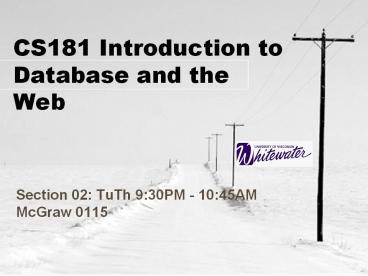CS181 Introduction to Database and the Web - PowerPoint PPT Presentation
1 / 23
Title:
CS181 Introduction to Database and the Web
Description:
Walmart: Records of retail business. Size of warehouses. Size of inventory ... software that lets people access and modify the database content ... – PowerPoint PPT presentation
Number of Views:46
Avg rating:3.0/5.0
Title: CS181 Introduction to Database and the Web
1
CS181 Introduction to Database and the Web
- Section 02 TuTh 930PM - 1045AM McGraw 0115
2
Course Objectives
- Create databases, tables, queries, forms and
write reports using RDBMS - Develop and publish web sites using HTML, and
CSS.
3
Textbook/Technology requirement
- Textbook
- 1. HTML for the World Wide Web with XHTML and
CSS. Elizabeth Castro. 2003. Peachpit Press. - 2. Special Edition Using Microsoft Access 2002.
Roger Jennings. 2002. Que Press. - Software
- Microsoft Access
4
Contact information
- harrisb_at_uww.edu
- McCutchan Hall 304
- Office Hours 330-500pm M-Th, or by
appointment - 262 472 5684
5
Course detail - Topics
Develop simple three tier application
Database (back-end)
HTML Javascript (front-end)
Connecting these two together
6
Course detail - Evaluation
GRADABLE POINTS
Quiz 100
Lab 100
Project 1 250
Project 2 200
Midterm exam 150
Final Exam 200
Totals 1000
7
Introduction to Database and Database Design
8
Introduction to Database
- Why are databases important?
- How do databases represent information?
- Who works with databases?
- How do databases support the World Wide Web?
- What database concepts and terms do you need to
know?
9
Why Are Databases Important?
- Importance to business
- Walmart Records of retail business
- Size of warehouses
- Size of inventory
- Average sales per of inventory
- Amazon.com Records of customers
- Importance to Web
- Records of interactions/transactions
- Example of auction site, customers
preferences/behaviors
10
Importance of Databases to Economy
- Expanding use of databases in retail sales
- Walmart, retail sales information tracking
- Examples of analyses
- Sales of items
- Comparisons between daily totals of items sold
and items in inventory seasonal variations in
sales of specific and similar items relative
sales of similar items with different features - Market-basket collections (all items in a single
purchase) - Average and variation in total purchase
amount/number price of items. - Correlation between sales of items in a single
purchase - Customer analysis
- Behavior of average customer
- Preferences of individual customers
11
How Do Databases Represent Information?
- The physical database
- a collection of files containing the data
content - The schema
- a specification of the physical databases
information content and logical structure - The database engine
- software that lets people access and modify the
database content - The data definition and manipulation languages
- programming languages, such as Java or SQL
(Structured Query Language), that let software
developers define the schema and access the
database
12
How Do Databases Represent Information?
- Relational database management system (RDBMS)
- Tables of data
- Schema
- Name of table
- Names and types of attributes
- Contents
- Row is a fact
- Attribute value is a characteristic
13
Example of storing information of a department
Department table Dept Manager Description
Department table 101 017-11-0031 Marketing
Department table 102 018-21-2131 Accounting
Department table 103 019-41-1231 Customer service
Schema Depts(dept,manager,description) Depts(dept,manager,description) Depts(dept,manager,description) Depts(dept,manager,description)
Table creation statement create table depts(dept char(3), manager char(11), description char(25)) create table depts(dept char(3), manager char(11), description char(25)) create table depts(dept char(3), manager char(11), description char(25)) create table depts(dept char(3), manager char(11), description char(25))
14
Example of storing information of a department
Insert data into table insert into depts (dept, manager,description) values ('001','017-11-0031',marketing')
15
Who Works with Database Systems?
- Database designers
- Applications developers
- Web-application developers
- Web-site designers
- Database administrators
16
How Do Databases Support the World Wide Web?
- Maintain information that is published in the
site - Track the ways in which site visitors use that
information - Track the number of site visitors and customers
- Store information collected from input forms such
as requests for customer addresses - Store the structure and content of Web pages
17
Information Systems
- Three separate types of functionality
- Data Management
- Application logic
- Presentation
18
Single-tier architecture
- All functionality combined into a single tier
(e.g mainframe where users access through dumb
terminal or stand-alone machine where there is no
server) - Pros easy maintenance and administration
- Cons missing GUI, single point failure
19
Client-server architecture
- Thin client
- Client implements only the GUI
- Server implements business logic and data
management - Pros easy maintenance and implementation
- Conscant separate between business logic and
data management
20
Client-server architecture
- Thick client
- Client implements both GUI and business logic
- Server implements data management
- Cons no central place to update the business
logic - Security trust clients
- Scalability problems with 100s of clients
21
Three tier architecture
Client program
Presentation tier
Application server
Middle tier
Data management tier
Database server
22
Three tier architecture
- Pros
- Heterogeneous systems
- Thin clients
- Integrated data access
- Scalability
- Development
- Code for business logic is centralized
- Interaction between tiers through well-defined
APIs.
23
Timeline for Database Systems Developments
- before 1960 transition from punched card and tape
- 1960s, from file management to databases
- 1970s, CODASYL and Relational Model
- Codd (IBM) Relational Model
- Chen introduced Entity Relationship Model
- Query languages developed (SQL)
- 1980s, Client/Server DBs, Oracle, DB2
- 1990s, web-based information delivery
- Trends expert DBs, object DBs, distributed DBs
- 2000s, Enhancing database technology for Web
storage and access - Bioinformatics genetic and protein information,
medical records - Using the Web as a database































